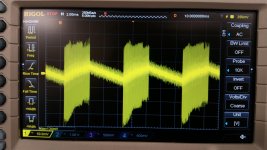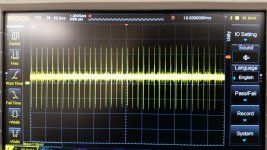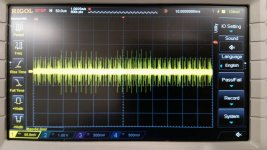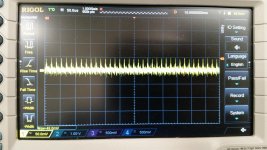Don't forget to reset gain resistors from 36dB to 26dB, that may be amplifying noise more than you like.
So the 20db gain is a no go? Has anyone successfully used regular resistors in place of the SMD resistors. I think can probably get them off, but replacing them with the same size SMD's is not for me.
If you have a big preamp stage that is fine. My RCA lineouts from a miniDSP cannot drive the amp to the rails with 20dB gain. Although some people (Pass) say you shouldn't have so much gain only to decrease the dynamic range by attenuating your preamp output, you should drive "at the speed limit" meaning, if you can get to about 70% of clipping you are good and should be happy. This will preserve headroom and keep things sounding cleaner.
You might be able to solder a tiny 1/8th watt resistor with pins standing up on legs. But that is no easier than holding an SMT resistor down with a tweezer while applying solder heat to the end. Need binocular flip up magnifiers. It will change the way you view SMT work.
You might be able to solder a tiny 1/8th watt resistor with pins standing up on legs. But that is no easier than holding an SMT resistor down with a tweezer while applying solder heat to the end. Need binocular flip up magnifiers. It will change the way you view SMT work.
Last edited:
I am having good luck with these units. They won't really do 9A, but they will crank out 6A continuous without a hitch.
AC Converter 110V 220V to 24V Max 9A 150W Regulated Transformer Power Supply | eBay
Little brothers, I haven't tested these yet, but I imagine they are decent based on my experience with the bigger one.
100W AC DC Converter 110V 220V to 24V DC 6A Power Supply Switching Transformer | eBay
AC 85 265V to DC 12V 8A AC DC 50 60Hz Switching Power Supply Module Board SL | eBay
Thanks for the link -looks promising. What is ripple on big one with no load?
Just saw Creative Soundblaster X7 on Massdrop, they give numbers for two different powersupplies, you'll get the picture when it might matter:
Maximum Power Output
•50W + 50W (4Ω, 1kHz, 10% THD)¹
•38W + 38W (4Ω, 1kHz, 10% THD)²
•27W + 27W (8Ω, 1kHz, 10% THD)¹
•27W + 27W (8Ω, 1kHz, 10% THD)²
Rated Power Output
•37W + 37W (4Ω, 1kHz, 1% THD)¹
•35W + 35W (4Ω, 1kHz, 1% THD)²
•22W + 22W (8Ω, 1kHz, 1% THD)¹
•20W + 20W (8Ω, 1kHz, 1% THD)²
Total Harmonic Distortion
•0.05% (1kHz, 4Ω, 33W)¹
•0.05% (1kHz, 4Ω, 30W)²
•¹ Requires upgrade to high power AC-DC adapter (24V 6A)
•² Using bundled AC-DC adapter (24V 2.91A)
Maximum Power Output
•50W + 50W (4Ω, 1kHz, 10% THD)¹
•38W + 38W (4Ω, 1kHz, 10% THD)²
•27W + 27W (8Ω, 1kHz, 10% THD)¹
•27W + 27W (8Ω, 1kHz, 10% THD)²
Rated Power Output
•37W + 37W (4Ω, 1kHz, 1% THD)¹
•35W + 35W (4Ω, 1kHz, 1% THD)²
•22W + 22W (8Ω, 1kHz, 1% THD)¹
•20W + 20W (8Ω, 1kHz, 1% THD)²
Total Harmonic Distortion
•0.05% (1kHz, 4Ω, 33W)¹
•0.05% (1kHz, 4Ω, 30W)²
•¹ Requires upgrade to high power AC-DC adapter (24V 6A)
•² Using bundled AC-DC adapter (24V 2.91A)
Thanks for the link -looks promising. What is ripple on big one with no load?
Not the best, but I would guess you could get a pretty big improvement by swapping out the "Chong" branded caps, before they go "Up In Smoke". Also seems that the chip is doing some kind of "burst mode" to regulate the voltage.
Attachments
Just to say, this passed the Diana Krall test much better then the Breezer 2.1 and the
TPA3116.
BUT!
A VERY but!
We hear music different, and im soon 60 and ofcourse im not hearing the highs as before.
And listening to a pair of a TABAQ with Tangband W4-1320 where it dies over 10khz.
I maybe happy.
But, Im not sure about the distorstion on the top?
If it is any?

TPA3116.
BUT!
A VERY but!
We hear music different, and im soon 60 and ofcourse im not hearing the highs as before.
And listening to a pair of a TABAQ with Tangband W4-1320 where it dies over 10khz.
I maybe happy.
But, Im not sure about the distorstion on the top?
If it is any?
Not the best, but I would guess you could get a pretty big improvement by swapping out the "Chong" branded caps, before they go "Up In Smoke". Also seems that the chip is doing some kind of "burst mode" to regulate the voltage.
I have one of these coming. Can you tell me what value capacitors are needed so I can order them today. Many thanks.
Just to say, this passed the Diana Krall test much better then the Breezer 2.1 and the
TPA3116.
BUT!
A VERY but!
We hear music different, and im soon 60 and ofcourse im not hearing the highs as before.
And listening to a pair of a TABAQ with Tangband W4-1320 where it dies over 10khz.
I maybe happy.
But, Im not sure about the distorstion on the top?
If it is any?

It's clean on top as you would expect from a well implemented TPA311x. Non issues there.
Not the best, but I would guess you could get a pretty big improvement by swapping out the "Chong" branded caps, before they go "Up In Smoke". Also seems that the chip is doing some kind of "burst mode" to regulate the voltage.
Oh that's kind of ugly. Is that 1v per division scale? My $6 SMPS 19v bricks are 16mV to 20mV of ripple.
The mains input capacitor is 18mm dia x 30mm tall with 7.5mm lead spacing.
The output capacitors (3x) are 10mm dia x 20mm tall with 5mm lead spacing.
Mains input cap is a 100uF 400V 105C
Output caps are 1000uF 35V 105C
I won't guarantee that it makes it amazing when you swap the caps, but it can't hurt, and it will definitely increase the lifespan. All of the other components actually look of reasonable quality and the layout is sensible. I may buy a spare to tear the transformer apart and check isolation. Unfortunately the top of the chip is sanded off so I can't look up the actual model either.
The output capacitors (3x) are 10mm dia x 20mm tall with 5mm lead spacing.
Mains input cap is a 100uF 400V 105C
Output caps are 1000uF 35V 105C
I won't guarantee that it makes it amazing when you swap the caps, but it can't hurt, and it will definitely increase the lifespan. All of the other components actually look of reasonable quality and the layout is sensible. I may buy a spare to tear the transformer apart and check isolation. Unfortunately the top of the chip is sanded off so I can't look up the actual model either.
Oh that's kind of ugly. Is that 1v per division scale? My $6 SMPS 19v bricks are 16mV to 20mV of ripple.
50mV per division, so when the switching engages it is around 300mV. Unfortunately when it is loaded down it maintains that 300mV ripple. I haven't noticed it manifesting as noise personally, but I am pretty insensitive to HF stuff. I listened to it before measuring, if anyone cares.
I plan to try out some mods to see if I can get that down. Even just tossing a small ceramic cap on the output could possibly work wonders. Will test some things out and re-measure later this week. I quite like the supply for basically anything but audio after measuring it, so getting that noise down would be nice, could be a good cheap go-to supply.
Just looked at my boards gain setting.
It´s R1 39k and R2 100k.
32db.
Dont know if it worth it to set it for 26db?
I like 32db better. it suits my TVC (transformer volume control) better and I did not find it "noisy" at all in my system.
Just looked at my boards gain setting.
It´s R1 39k and R2 100k.
32db.
Dont know if it worth it to set it for 26db?
32dB is probably just fine - listen to it and if range suits you, you are good.
That looks like the right Sanwu 3118 PBTL monoblock based on the drawing. The photo did not show up.
So the noise isn't really as bad as it seems in that first image, was way zoomed out on the signal.
Here I took 3 at 50us/div, in other words, the noise would have to be slower than 1 pulse per division to hear it. There is 1 of the module from China, one of a 19V Dell laptop brick made by Delta, and one of a 12V Mean Well supply.
These are still not the best measurements, what with the giant ground loops on my scope probe and all.
I need to find a small ceramic cap to put directly on the output terminals which will have self resonance at the frequency of the noise, should take care of most of the nasty HF stuff.
Then either swapping the main output caps with better electrolytic, or more likely just paralleling a few ceramics should get rid of the small amount of LF stuff there is.
Here I took 3 at 50us/div, in other words, the noise would have to be slower than 1 pulse per division to hear it. There is 1 of the module from China, one of a 19V Dell laptop brick made by Delta, and one of a 12V Mean Well supply.
These are still not the best measurements, what with the giant ground loops on my scope probe and all.
I need to find a small ceramic cap to put directly on the output terminals which will have self resonance at the frequency of the noise, should take care of most of the nasty HF stuff.
Then either swapping the main output caps with better electrolytic, or more likely just paralleling a few ceramics should get rid of the small amount of LF stuff there is.
Attachments
No worries. I work in power electronics, although we primarily deal with batteries and DC-DC, and I am technically an ME, I just pretend to know what I am talking about in EE, not the point. An SMPS is basically just a rectifier and a buck regulator, so the principal is the same as on the DC-DCs I have dealt with. There is almost always a relatively simply way to get it down to an acceptable level. Here is a good write up from TI on the subject.
https://e2e.ti.com/support/power_ma...-measuring-and-reducing-output-voltage-ripple
Keep in mind also, that although the noise does get lower as we go through those 3 supplies, it isn't as startling as it looks. Taken as a percentage of full scale we have a 0.7%, 0.6% and 0.5% noise level. That difference is nothing to scoff at, but it isn't as night and day as the pictures would make it seem either.
https://e2e.ti.com/support/power_ma...-measuring-and-reducing-output-voltage-ripple
Keep in mind also, that although the noise does get lower as we go through those 3 supplies, it isn't as startling as it looks. Taken as a percentage of full scale we have a 0.7%, 0.6% and 0.5% noise level. That difference is nothing to scoff at, but it isn't as night and day as the pictures would make it seem either.
Last edited:
I found an SMPS in my drawer that I forgotten.It gives 16v and is very quiet.I like 32db better. it suits my TVC (transformer volume control) better and I did not find it "noisy" at all in my system.
But a small hiss there is, changed to my Kingrex PSU 12V wich is dead quiet with my Tripath.
Same noice.
Is it maybe there the cheapness in some components fail?
- Home
- Amplifiers
- Class D
- Cheap TPA3118D2 boards, modding them and everything that comes with it



